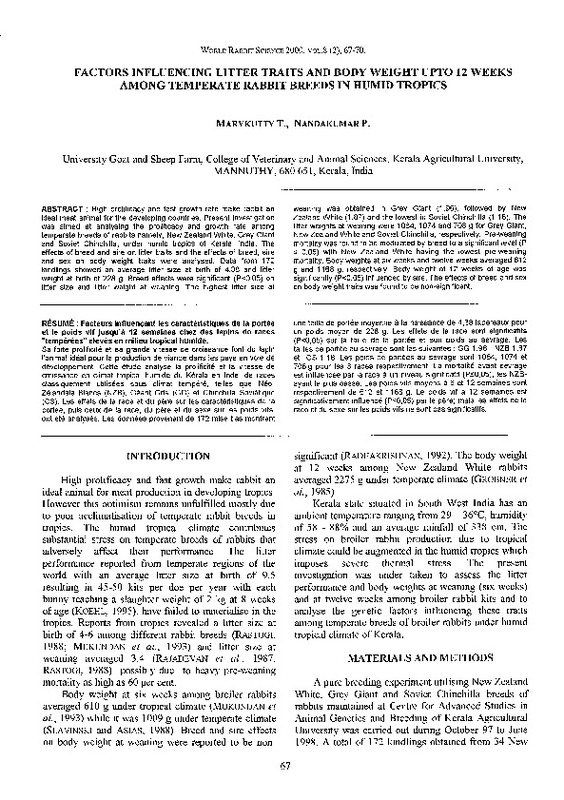JavaScript is disabled for your browser. Some features of this site may not work without it.
Buscar en RiuNet
Listar
Mi cuenta
Estadísticas
Ayuda RiuNet
Admin. UPV
FACTORS INFLUENCING LITTER TRAITS AND BODY WEIGHT UPTO 12 WEEKS AMONG TEMPERATE RABBIT BREEDS IN HUMID TROPICS
Mostrar el registro sencillo del ítem
Ficheros en el ítem
| dc.contributor.author | Marykutty, T.
|
|
| dc.contributor.author | Nandakumar, P.
|
|
| dc.date.accessioned | 2011-03-08T13:14:21Z | |
| dc.date.available | 2011-03-08T13:14:21Z | |
| dc.date.issued | 2000 | |
| dc.identifier.issn | 1257-5011 | |
| dc.identifier.uri | http://hdl.handle.net/10251/10231 | |
| dc.description.abstract | [EN] High prolificacy and fast growth rate make rabbit an ideal meat animal for the developing countries. Present investigation was aimed at analysing the prolificacy and growth rate among temperate breeds of rabbits namely, New Zealand White, Grey Giant and Soviet Chinchilla, under humid tropics of Kerala, India. The effects of breed and sire on litter traits and the effects of breed, sire and sex on body weight traits were analysed. Data from 172 kindlings showed an average litter size at birth of 4.38 and litter weight at birth of 228 g. Breed effects were significan! (P<0.05) on litter size and litter weight at weaning. The highest litter size at weaning was obtained in Grey Giant (1 .96), followed by New Zealand White (1.87) and the lowest in Soviet Chinchilla (1.18). The litter weights al weaning were 1084, 1074 and 708 g for Grey Giant, New Zealand White and Soviet Chinchilla, respectively. Pre-weaning mortality was found to be modulated by breed to a significan! level (P s 0.05) with New Zealand White having the lowest pre-weaning mortality. Body weights al six weeks and twelve weeks averaged 612 g and 1168 g, respectively. Body weight at 12 weeks of age was significantly (P<0.05) influenced by sire. The effects of breed and sex on body weight traits was found to be non-significan!. | es_ES |
| dc.description.abstract | [FR] Sa forte prolificité et sa grande vitesse de croissance fon! du lapin !'animal idéal pour la production de viande dans les pays en voie de développement. Cette étude analyse la prolificité et la vitesse de croissance en clima! tropical humide du Kérala en lnde, de races classiquement utilisées sous clima! tempéré, !elles que NéoZélandais Blancs (NZB), Géant Gris (GG) et Chinchilla Soviétique (CS). Les effets de la race et du pére sur les caractéristiques de la portée, puis ceux de la race, du pére et du sexe sur les poids vifs, ont été analysés. Les données provenant de 172 mise bas montrent une taille de portée moyenne a la naissance de 4,38 lapereaux pour un poids mayen de 228 g. Les effets de la race sont significatifs (P<0,05) sur la taille de la portée et son poids au sevrage. Les tailles de portée au sevrage sont les suivantes: GG 1,96 - NZB 1,87 et es 1,18. Les poids de portées au sevrage sont 1084, 1074 et 708 g pour les 3 races respectivement. La mortalité avant sevrage est influencée par la race a un niveau significatif (Ps0,05), les NZBayant la plus basse. Les poids vifs moyens a 6 et 12 semaines sont respectivement de 612 et 1168 g. Le poids vif a 12 semaines est significativement influencé (Ps0,05) par le pére; mais les effets de la race et du sexe sur les poids vifs ne sont pas significatifs. | |
| dc.language | Inglés | es_ES |
| dc.publisher | World Rabbit Science. ICTA. UPV | es_ES |
| dc.relation.ispartof | World Rabbit Science | |
| dc.rights | Reserva de todos los derechos | es_ES |
| dc.title | FACTORS INFLUENCING LITTER TRAITS AND BODY WEIGHT UPTO 12 WEEKS AMONG TEMPERATE RABBIT BREEDS IN HUMID TROPICS | es_ES |
| dc.type | Artículo | es_ES |
| dc.date.updated | 2011-03-08T12:56:28Z | |
| dc.identifier.doi | 10.4995/wrs.2000.421 | |
| dc.rights.accessRights | Abierto | es_ES |
| dc.description.bibliographicCitation | Marykutty, T.; Nandakumar, P. (2000). FACTORS INFLUENCING LITTER TRAITS AND BODY WEIGHT UPTO 12 WEEKS AMONG TEMPERATE RABBIT BREEDS IN HUMID TROPICS. World Rabbit Science. 08(2). https://doi.org/10.4995/wrs.2000.421 | es_ES |
| dc.description.accrualMethod | SWORD | es_ES |
| dc.relation.publisherversion | https://doi.org/10.4995/wrs.2000.421 | |
| dc.description.volume | 08 | |
| dc.description.issue | 2 | |
| dc.identifier.eissn | 1989-8886 | es_ES |








